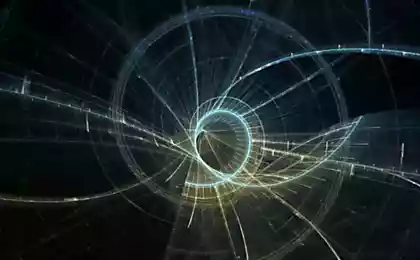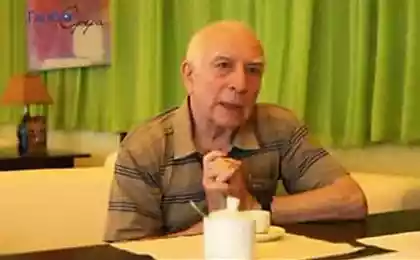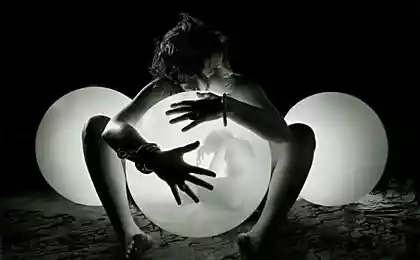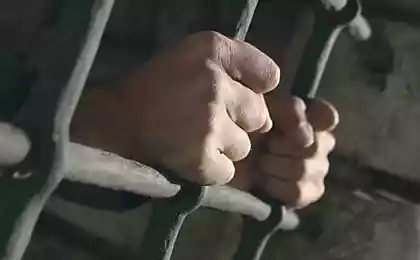509
The future affects the past? Scientists have confirmed the quantum thought experiment of Wheeler
In the study of the behavior of quantum particles, scientists from the Australian national University have confirmed that a quantum particle can behave so oddly that they seem to violate the principle of causality.

Professor Andrew Truscott and student Roman Khakimov bravely look into the quantum world
This principle is one of the fundamental laws, which few people dispute. Although many physical quantities and phenomena do not change if we turn back the clock (are T-even), there is a fundamental empirically established principle: an event A can affect event B only if event B happened later. From the point of view of classical physics — just too late from the point of view of STO — later in any system of reference, i.e., is in the light cone with vertex at A.
So far only science fiction writers grapple with the "grandfather paradox" (I remember the story, which was that my grandfather actually was innocent, and had to deal with grandma). In physics, a journey into the past usually associated with traveling faster than the speed of light, and that's where it was all quiet.
Except for one thing — quantum physics. There is generally a lot of strange. For example, the classic double-slit experiment. If we place a barrier with a slit in the path of the source particles (e.g., photons), and it will put the screen on the screen we will see stripes. Logical. But if we do the obstacle two slits on the screen we see not two strips, and picture interference. Particles passing through the slits, behave as waves and interfere with each other.

To exclude the possibility that the particles on the fly collide with each other and therefore do not draw on our screen two distinct bands, you can release them one by one. And still, after some time the screen will draw the interference pattern. Particles magically interfere with themselves! This is much less logical. It turns out that the particle goes through two slits — otherwise, how can it interfere?
And then — even more interesting. If we try to understand what all the same the crack passes the particle, when trying to establish this fact, the particles instantly begin to behave like particles and cease to interfere with themselves. That is, the particles are practically "feel" the presence of a detector at the slits. Moreover, interference is obtained not only with photons or electrons, and even with quite large by quantum standards particles. To exclude the possibility that the detector is somehow "spoils" of the incoming particles, was delivered fairly complex experiments.
For example, in 2004 an experiment was conducted with a beam of fullerene (C70 molecules containing 70 carbon atoms). The beam was scattered from a diffraction grating consisting of a large number of narrow slits. Thus the experimenters could be controlled and heat flying in the beam of molecules through the laser beam, that allows to change their internal temperature (average energy of the vibrations of carbon atoms within these molecules).
Any hot body emits thermal photons, the spectrum of which reflects the average energy of transitions between the possible States of the system. In several such photons can, in principle, up to the wavelength of the emitted quantum, to determine the trajectory opustevshij their molecules. The higher the temperature and shorter the wavelength of the quantum, the more accuracy we could determine the position of molecules in space, and at a certain critical temperature, the accuracy will be sufficient to determine what exactly the cracks were responsible for the scattering.
Accordingly, if someone surrounded the installation of sophisticated detectors of photons, it is, in principle, could establish on which of the slits the diffraction grating dispersed fullerene. In other words, the molecule emission of light quanta would give the experimenter the information to separate the component of the superposition that gave us passage detector. However, there are no detectors around the system.
In the experiment it was found that in the absence of laser heating there is an interference pattern, quite similar to the pattern from two slits in the experiment with electrons. The inclusion of laser heating leads first to a weakening of the interference contrast, and then, with increasing heating output, to the complete disappearance of interference effects. It was established that at temperatures T < 1000K molecules behave as quantum particles, and at T > 3000K, when the trajectory of fullerenes "fixed" environment with the necessary accuracy as a classical body.
Thus, the role of a detector able to identify the components of the superposition, were capable of performing environment. It in interaction with thermal photons in one form or another, and recording information about the trajectory and state of the fullerene molecule. And it does not matter what information is exchanged through a specially staged detector environment or to humans.
For the destruction of coherence of States and the disappearance of the interference pattern is significant only fundamental the availability of information through which of the slits the particle has passed — and who will get it and get there, doesn't matter. It is only important that this information it is possible to.
You think this is the strangest manifestation of quantum mechanics? As it is not so. Physicist John Wheeler suggested in the late 70's thought experiment, which he called "an experiment with delayed choice." His reasoning was simple and logical.
Well, let's say that the photon in some unknown way learns that it will or will not try to detect, before approaching the cracks. After all, he must somehow decide to behave like a wave and pass through both slits at once (in order to meet the interference pattern on the screen), or to pretend to be a particle, and through only one of the two slots. But he needs to do before it will be held through the cracks, right? After this it is too late — there's either ride like a small ball or interferers in full.
So let's, suggested Wheeler, position the screen away from the slits. And the screen has put two telescopes, each of which will focus on one of the slits, and will only react to the passage of the photon through one of them. And will arbitrarily remove the screen after the photon will be slit, as if he tried to pass.

If we do not remove the screen, then in theory, it should always be picture interference. And if we are going to clean it up — then either the photon strikes one of the telescopes, particle (he went through one of the slits) or both of the telescope will see more than a faint glow (it went through both slits, and each of them saw your plot of the interference pattern).
In 2006 progress in physics has allowed scientists to put such an experiment with a photon really is. It was found that if the screen is not clean, it is always visible picture interference, but if removed you can keep track of through which slit the photon passed. Speaking from the point of view of logic familiar to us, we come to a disappointing conclusion. Our action according to the decision, we remove the screen or not, affect the behavior of the photon, despite the fact that the action is in the future relative to the "decision" of a photon is about how to pass the gap. That is, either the future affects the past, or in the interpretation of what is happening in the experiment with slots there is something fundamentally wrong.
Australian scientists have repeated this experiment only instead of a photon, they used a helium atom. An important difference between this experiment is the fact that the atom, in contrast to the photon has the rest mass and internal degrees of freedom. Only instead of barriers with slits and the screen they used the mesh created with laser beams. It gave them the opportunity to immediately obtain information about the behavior of particles.
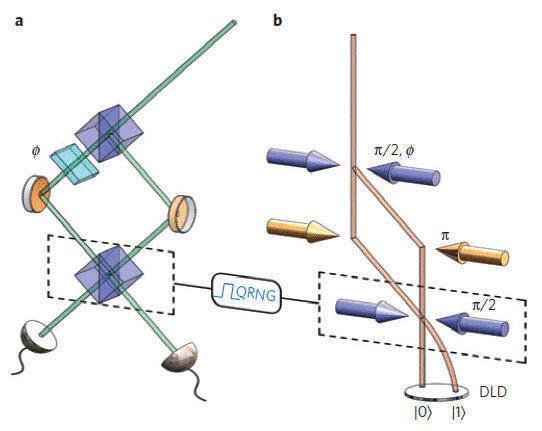
As one would expect (although with quantum physics is unlikely to expect something), the atom behaved in exactly the same way as the photon. The decision on whether or not to exist in the way of the atom the "screen" was made on the basis of quantum random number generator. The generator was according to the relativistic standards of the separated atoms, i.e. no interaction between them could not be.
It turns out that individual atoms have mass and charge, they behave just as individual photons. And let it not be the most breakthrough in the quantum field experience, but it confirms the fact that the quantum world really is not what we can imagine it. published
P. S. And remember, only by changing their consumption — together we change the world! ©
Source: geektimes.ru/post/251826/

Professor Andrew Truscott and student Roman Khakimov bravely look into the quantum world
This principle is one of the fundamental laws, which few people dispute. Although many physical quantities and phenomena do not change if we turn back the clock (are T-even), there is a fundamental empirically established principle: an event A can affect event B only if event B happened later. From the point of view of classical physics — just too late from the point of view of STO — later in any system of reference, i.e., is in the light cone with vertex at A.
So far only science fiction writers grapple with the "grandfather paradox" (I remember the story, which was that my grandfather actually was innocent, and had to deal with grandma). In physics, a journey into the past usually associated with traveling faster than the speed of light, and that's where it was all quiet.
Except for one thing — quantum physics. There is generally a lot of strange. For example, the classic double-slit experiment. If we place a barrier with a slit in the path of the source particles (e.g., photons), and it will put the screen on the screen we will see stripes. Logical. But if we do the obstacle two slits on the screen we see not two strips, and picture interference. Particles passing through the slits, behave as waves and interfere with each other.

To exclude the possibility that the particles on the fly collide with each other and therefore do not draw on our screen two distinct bands, you can release them one by one. And still, after some time the screen will draw the interference pattern. Particles magically interfere with themselves! This is much less logical. It turns out that the particle goes through two slits — otherwise, how can it interfere?
And then — even more interesting. If we try to understand what all the same the crack passes the particle, when trying to establish this fact, the particles instantly begin to behave like particles and cease to interfere with themselves. That is, the particles are practically "feel" the presence of a detector at the slits. Moreover, interference is obtained not only with photons or electrons, and even with quite large by quantum standards particles. To exclude the possibility that the detector is somehow "spoils" of the incoming particles, was delivered fairly complex experiments.
For example, in 2004 an experiment was conducted with a beam of fullerene (C70 molecules containing 70 carbon atoms). The beam was scattered from a diffraction grating consisting of a large number of narrow slits. Thus the experimenters could be controlled and heat flying in the beam of molecules through the laser beam, that allows to change their internal temperature (average energy of the vibrations of carbon atoms within these molecules).
Any hot body emits thermal photons, the spectrum of which reflects the average energy of transitions between the possible States of the system. In several such photons can, in principle, up to the wavelength of the emitted quantum, to determine the trajectory opustevshij their molecules. The higher the temperature and shorter the wavelength of the quantum, the more accuracy we could determine the position of molecules in space, and at a certain critical temperature, the accuracy will be sufficient to determine what exactly the cracks were responsible for the scattering.
Accordingly, if someone surrounded the installation of sophisticated detectors of photons, it is, in principle, could establish on which of the slits the diffraction grating dispersed fullerene. In other words, the molecule emission of light quanta would give the experimenter the information to separate the component of the superposition that gave us passage detector. However, there are no detectors around the system.
In the experiment it was found that in the absence of laser heating there is an interference pattern, quite similar to the pattern from two slits in the experiment with electrons. The inclusion of laser heating leads first to a weakening of the interference contrast, and then, with increasing heating output, to the complete disappearance of interference effects. It was established that at temperatures T < 1000K molecules behave as quantum particles, and at T > 3000K, when the trajectory of fullerenes "fixed" environment with the necessary accuracy as a classical body.
Thus, the role of a detector able to identify the components of the superposition, were capable of performing environment. It in interaction with thermal photons in one form or another, and recording information about the trajectory and state of the fullerene molecule. And it does not matter what information is exchanged through a specially staged detector environment or to humans.
For the destruction of coherence of States and the disappearance of the interference pattern is significant only fundamental the availability of information through which of the slits the particle has passed — and who will get it and get there, doesn't matter. It is only important that this information it is possible to.
You think this is the strangest manifestation of quantum mechanics? As it is not so. Physicist John Wheeler suggested in the late 70's thought experiment, which he called "an experiment with delayed choice." His reasoning was simple and logical.
Well, let's say that the photon in some unknown way learns that it will or will not try to detect, before approaching the cracks. After all, he must somehow decide to behave like a wave and pass through both slits at once (in order to meet the interference pattern on the screen), or to pretend to be a particle, and through only one of the two slots. But he needs to do before it will be held through the cracks, right? After this it is too late — there's either ride like a small ball or interferers in full.
So let's, suggested Wheeler, position the screen away from the slits. And the screen has put two telescopes, each of which will focus on one of the slits, and will only react to the passage of the photon through one of them. And will arbitrarily remove the screen after the photon will be slit, as if he tried to pass.

If we do not remove the screen, then in theory, it should always be picture interference. And if we are going to clean it up — then either the photon strikes one of the telescopes, particle (he went through one of the slits) or both of the telescope will see more than a faint glow (it went through both slits, and each of them saw your plot of the interference pattern).
In 2006 progress in physics has allowed scientists to put such an experiment with a photon really is. It was found that if the screen is not clean, it is always visible picture interference, but if removed you can keep track of through which slit the photon passed. Speaking from the point of view of logic familiar to us, we come to a disappointing conclusion. Our action according to the decision, we remove the screen or not, affect the behavior of the photon, despite the fact that the action is in the future relative to the "decision" of a photon is about how to pass the gap. That is, either the future affects the past, or in the interpretation of what is happening in the experiment with slots there is something fundamentally wrong.
Australian scientists have repeated this experiment only instead of a photon, they used a helium atom. An important difference between this experiment is the fact that the atom, in contrast to the photon has the rest mass and internal degrees of freedom. Only instead of barriers with slits and the screen they used the mesh created with laser beams. It gave them the opportunity to immediately obtain information about the behavior of particles.

As one would expect (although with quantum physics is unlikely to expect something), the atom behaved in exactly the same way as the photon. The decision on whether or not to exist in the way of the atom the "screen" was made on the basis of quantum random number generator. The generator was according to the relativistic standards of the separated atoms, i.e. no interaction between them could not be.
It turns out that individual atoms have mass and charge, they behave just as individual photons. And let it not be the most breakthrough in the quantum field experience, but it confirms the fact that the quantum world really is not what we can imagine it. published
P. S. And remember, only by changing their consumption — together we change the world! ©
Source: geektimes.ru/post/251826/


